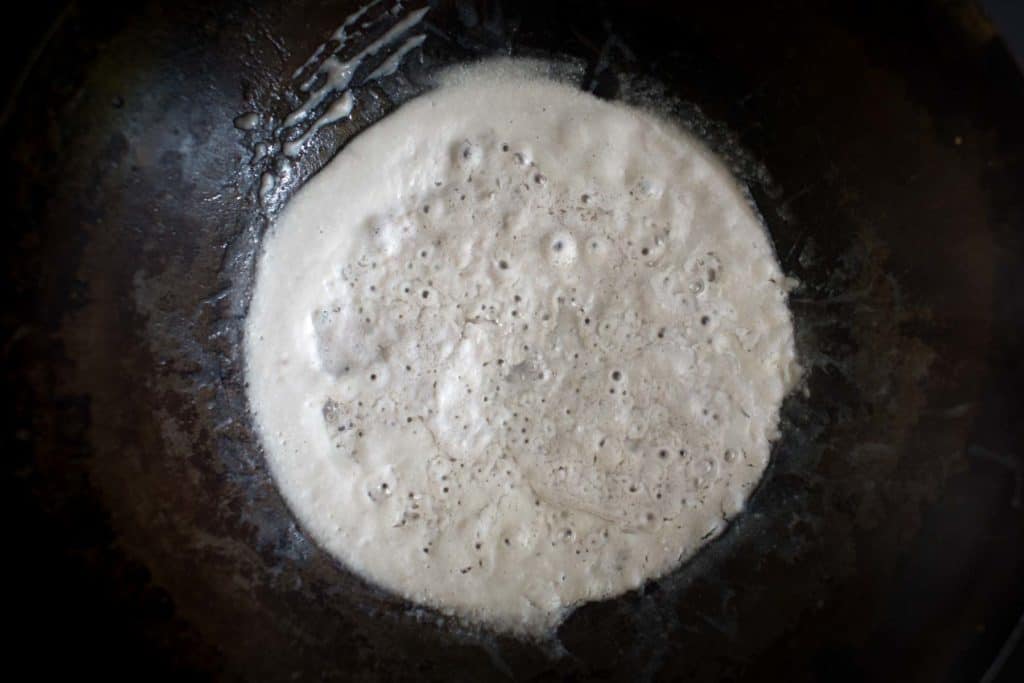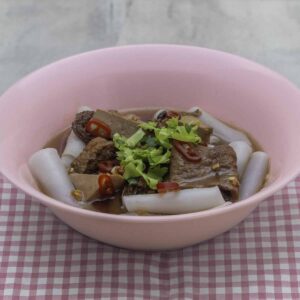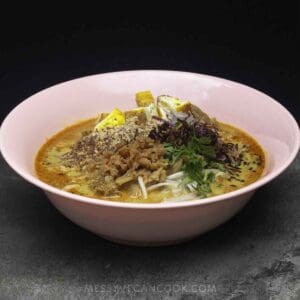There are three major methods of preparing curries in Thailand. One, more common in the North, is the rudimentary boiling method that involves heating curry paste in water or stock. Fried curries can either involve frying the paste in oil or frying the paste in cracked coconut cream before adding liquid ingredients.
The latter is the least known method outside of South East Asia, mainly due to our lack of hand-making fresh coconut cream, but it’s an important step in most of the typical curries you’re likely to order in a restaurant or prepare at home (e.g. red, green, masuman, panang, etc…).
Cracked coconut cream
When simmered over heat for a short while, much of the water from coconut cream evaporates and then the coconut milk fats and solids separate. When a recipe specifies frying in cracked coconut cream, it’s referring to this separated oil.

If you’ve ever made your own curry paste and added it straight to the coconut milk to simmer then you may have noticed some overpowering flavours dominating, like raw garlic. The reason? The curry paste was meant to be fried first, a process that integrates the flavours. I find this isn’t as great an issue with packaged curry pastes as they’ve had time for the flavours to mellow (think about the difference in garlic pungency between a freshly made batch of hummus versus how it tastes after a day or two).
To make cracked coconut cream, simmer coconut cream over low heat for around ten minutes until the liquid begins to separate into a curdled mass. You will see visible droplets of oil. This is the point at which curry paste is added and fried.
Canned coconut milk and cream is homogenised and often includes stabilisers that emulsify the fat and water in coconut milk, making it often impossible to crack. Brands of coconut milk I have had success with include Arroy-D, Chaokoh, and Kraw Thip (i.e. those without stabilisers and high in fat). Strictly speaking, the coconut cream is the thicker white liquid that rises to the top of coconut milk (this is more apparent if your coconut milk is homemade), but I often tip the whole can in the wok and just wait for the additional water to evaporate out. Same end result.
Nothing can truly replicate curry prepared properly by cracking fresh coconut cream, but not everyone has the time nor desire to go down the road of extracting cream from coconut flesh. My advice in such cases is to try cracking canned milk. If that doesn’t work then an adequate solution is to faux fry curry pastes by adding a little vegetable or coconut oil to the cream/milk.





Kate says
I really shouldn't hit the MoFo RSS until later in the day - now I want curry for breakfast 😉
I nominated you for a Liebster award! (http://www.oddlittlevegan.com/about-me/liebster-award-and-tofu-scramble/) Apologies if you've already been nominated, but I couldn't see it anywhere on your site. Don't worry if you don't want to do it, it's all just a bit of fun 🙂
Kip says
Thanks for the nomination! I'm super busy at the moment and will be away for the next couple of months, so maybe next time I will have the time to participate 🙂
Ksenia of At the Immigrant's T says
Great, clear discussion of a little-known and traditional curry-making approach. I'll be looking for those brands in my store!
Claryn says
This is so cool, Kip! Thanks for the lesson 🙂
Kip says
Thanks for reading 🙂
Agnes Ardiyanti says
Thank you for the tip. Making Indonesian rendang requires the same step, and I haven’t managed to succesfully crack the canned coconut oil. Being an Indonesian, it hurts my pride that i can’t make a proper rendang. Luckily the coconut oil brands you mentioned can be found here (Holland). I will try slowly boiling the cream next time I make rendang!
Kip says
Ahhh good luck! It can be frustrating and can take ages (Aroy-D cartons now contain emulsifiers so it takes longer to crack but it will work eventually)
I reserve the right to improve malicious and trollish comments.